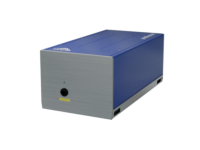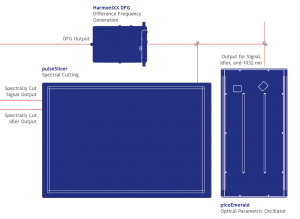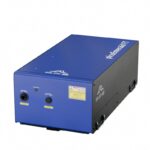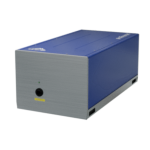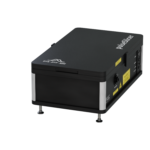Excitation Source for Quantum Dot Single-Photon and Entangled Photon Generation
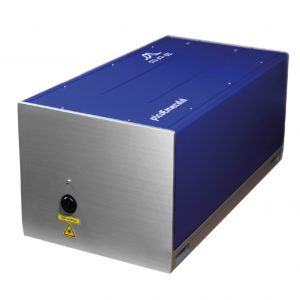
picoEmerald & pulseSlicer: Ultimate control of the emission process of quantum dots single photon generation with a pulsed picosecond laser source
The realization of a quantum dot single-photon source or the creation of entangled photons is often based on three key elements: a quantum dot emitter, appropriate control of the emission process, and non-linear optical processes.
Controlled single-photon generation “on demand”, i.e. by means of a trigger event, can be achieved by pulsed excitation of the single photon emitter. Picosecond (ps) lasers are particularly suitable for the pulsed excitation of quantum dots. Compared to femtosecond sources, picosecond lasers are particularly narrow-band. They therefore enable resonant excitation of the QD emitter with very high efficiency and without disturbing background emissions.
The optimum degree of narrowness to achieve resonant excitation conditions depends on the properties of the individual quantum dot emitter system. And obviously, the resonant excitation of the QD system also depends on the center wavelength of the pulsed light source. Therefore, it can be seen as an advantage to use a pulsed and wavelength-tunable ps-source whose degree of narrowness is adjustable.
The combination of the tunable ps laser picoEmerald FT or picoEmerald S and the spectrum slicer (laser monochromator) pulseSlicer from APE offers this possibility and supports its customers in the field of quantum research, quantum-microscopy, or ghost imaging.
Key Features
- Small bandwidths because resonances in the single-photon sample are close to each other (selectivity)
- Wavelength tunability of the picosecond laser to respond to different resonances
- Wavelength tunability for spectroscopy (different resonances are addressed)
- Two colors simultaniously available
- Variable bandwidths to optimally address resonances of different widths (realization with pulseSlicer)
- High repetition rate for small time constants, since the relatively weak single-photon signals have to be accumulated over a large number of measurements
- High spectral power density ( = small bandwidth) given by picosecond laser excitation
- picoEmerald offers larger tuning range compared to Ti:Sa (1500 nm is not available with TiSa); a Ti:Sa in combination with an OPO would be possible, but the power density would be very low
- Further wavelength tunability into the mid-infrared with the DFG possible
- Additional automation of the bandwidth (via the pulseSlicer) in combination with the picoEmerald
Specifications
| Combination of picoEmerald S & pulseSlicer F100 | ||
| Wavelength Range | (others on request) | (others on request) |
| Spectral Bandwidth | 0.02 … 1.0 nm at 990 nm (2 … 70 ps) | 0.03 … 2.6 nm at 1600 nm (2 … 90 ps) |
| Overall Output Average Power | > 10 mW at 930 nm at 0.03 nm resolution | > 3 mW at 1550 nm at 0.1 nm resolution |
| Repetition Rate | 40 MHz with picoEmerald FT |
|
| Polarization | ||
| Software and Automation | ||
| Remote Control | ||
Datasheets & Brochures
APE_Quantum_Dot_Single_rev._4.0.0 (pdf / english)
or
Email & Phone Contacts
APE has distributors around the world to give you the best support. Choose a country to find your local sales contact:

